CHEVROLET CORVETTE 2007 6.G User Guide
Manufacturer: CHEVROLET, Model Year: 2007, Model line: CORVETTE, Model: CHEVROLET CORVETTE 2007 6.GPages: 488, PDF Size: 2.62 MB
Page 11 of 488
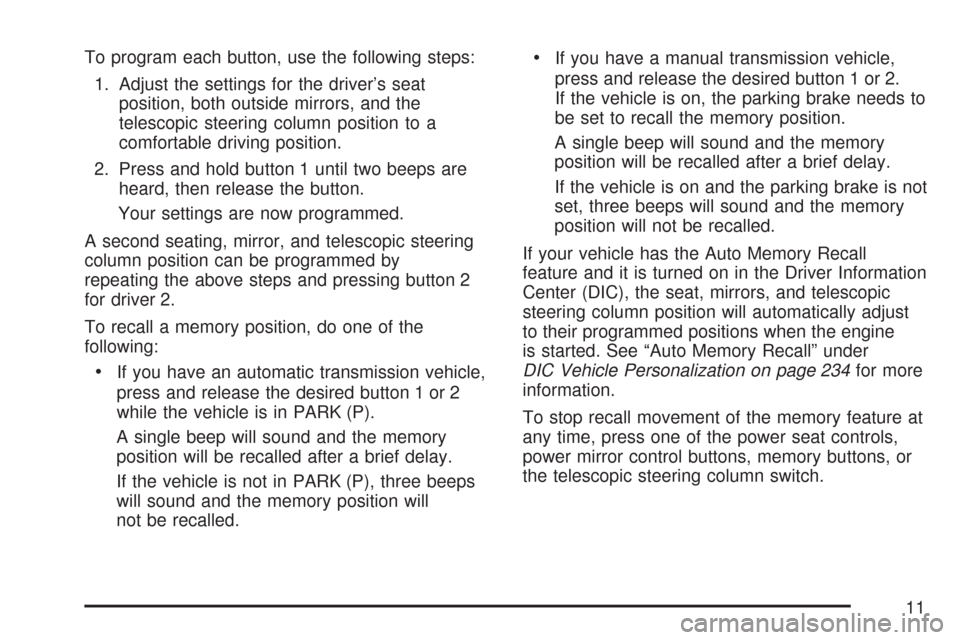
To program each button, use the following steps:
1. Adjust the settings for the driver’s seat
position, both outside mirrors, and the
telescopic steering column position to a
comfortable driving position.
2. Press and hold button 1 until two beeps are
heard, then release the button.
Your settings are now programmed.
A second seating, mirror, and telescopic steering
column position can be programmed by
repeating the above steps and pressing button 2
for driver 2.
To recall a memory position, do one of the
following:
If you have an automatic transmission vehicle,
press and release the desired button 1 or 2
while the vehicle is in PARK (P).
A single beep will sound and the memory
position will be recalled after a brief delay.
If the vehicle is not in PARK (P), three beeps
will sound and the memory position will
not be recalled.
If you have a manual transmission vehicle,
press and release the desired button 1 or 2.
If the vehicle is on, the parking brake needs to
be set to recall the memory position.
A single beep will sound and the memory
position will be recalled after a brief delay.
If the vehicle is on and the parking brake is not
set, three beeps will sound and the memory
position will not be recalled.
If your vehicle has the Auto Memory Recall
feature and it is turned on in the Driver Information
Center (DIC), the seat, mirrors, and telescopic
steering column position will automatically adjust
to their programmed positions when the engine
is started. See “Auto Memory Recall” under
DIC Vehicle Personalization on page 234for more
information.
To stop recall movement of the memory feature at
any time, press one of the power seat controls,
power mirror control buttons, memory buttons, or
the telescopic steering column switch.
11
Page 12 of 488
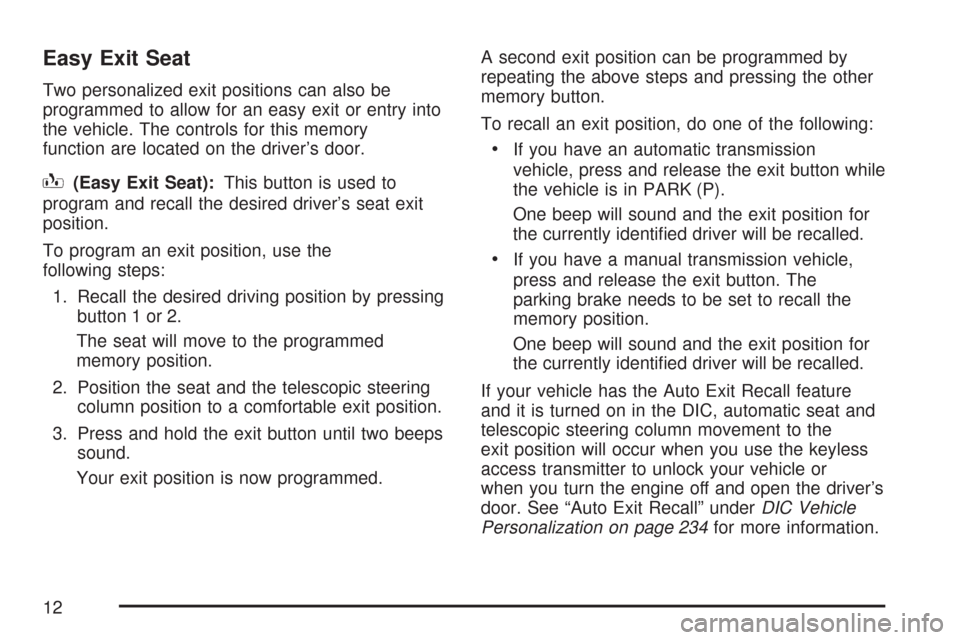
Easy Exit Seat
Two personalized exit positions can also be
programmed to allow for an easy exit or entry into
the vehicle. The controls for this memory
function are located on the driver’s door.
B(Easy Exit Seat):This button is used to
program and recall the desired driver’s seat exit
position.
To program an exit position, use the
following steps:
1. Recall the desired driving position by pressing
button 1 or 2.
The seat will move to the programmed
memory position.
2. Position the seat and the telescopic steering
column position to a comfortable exit position.
3. Press and hold the exit button until two beeps
sound.
Your exit position is now programmed.A second exit position can be programmed by
repeating the above steps and pressing the other
memory button.
To recall an exit position, do one of the following:
If you have an automatic transmission
vehicle, press and release the exit button while
the vehicle is in PARK (P).
One beep will sound and the exit position for
the currently identi�ed driver will be recalled.
If you have a manual transmission vehicle,
press and release the exit button. The
parking brake needs to be set to recall the
memory position.
One beep will sound and the exit position for
the currently identi�ed driver will be recalled.
If your vehicle has the Auto Exit Recall feature
and it is turned on in the DIC, automatic seat and
telescopic steering column movement to the
exit position will occur when you use the keyless
access transmitter to unlock your vehicle or
when you turn the engine off and open the driver’s
door. See “Auto Exit Recall” underDIC Vehicle
Personalization on page 234for more information.
12
Page 13 of 488
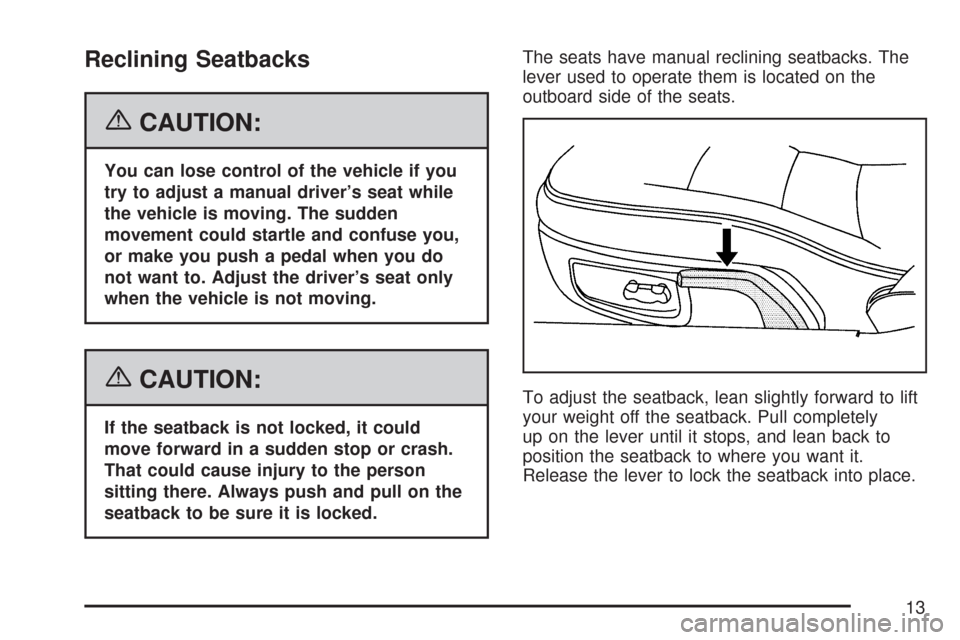
Reclining Seatbacks
{CAUTION:
You can lose control of the vehicle if you
try to adjust a manual driver’s seat while
the vehicle is moving. The sudden
movement could startle and confuse you,
or make you push a pedal when you do
not want to. Adjust the driver’s seat only
when the vehicle is not moving.
{CAUTION:
If the seatback is not locked, it could
move forward in a sudden stop or crash.
That could cause injury to the person
sitting there. Always push and pull on the
seatback to be sure it is locked.The seats have manual reclining seatbacks. The
lever used to operate them is located on the
outboard side of the seats.
To adjust the seatback, lean slightly forward to lift
your weight off the seatback. Pull completely
up on the lever until it stops, and lean back to
position the seatback to where you want it.
Release the lever to lock the seatback into place.
13
Page 14 of 488
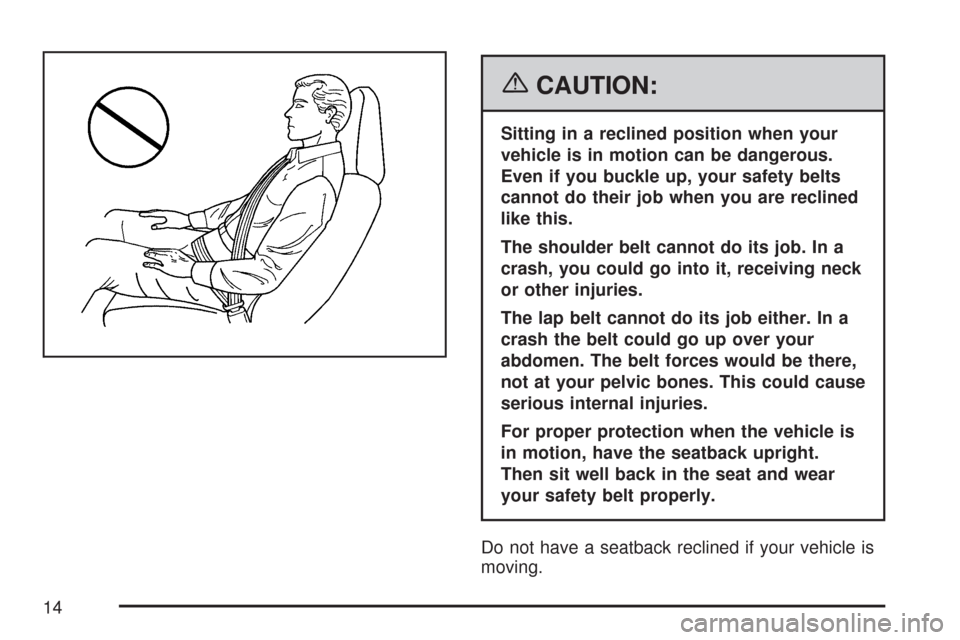
{CAUTION:
Sitting in a reclined position when your
vehicle is in motion can be dangerous.
Even if you buckle up, your safety belts
cannot do their job when you are reclined
like this.
The shoulder belt cannot do its job. In a
crash, you could go into it, receiving neck
or other injuries.
The lap belt cannot do its job either. In a
crash the belt could go up over your
abdomen. The belt forces would be there,
not at your pelvic bones. This could cause
serious internal injuries.
For proper protection when the vehicle is
in motion, have the seatback upright.
Then sit well back in the seat and wear
your safety belt properly.
Do not have a seatback reclined if your vehicle is
moving.
14
Page 15 of 488
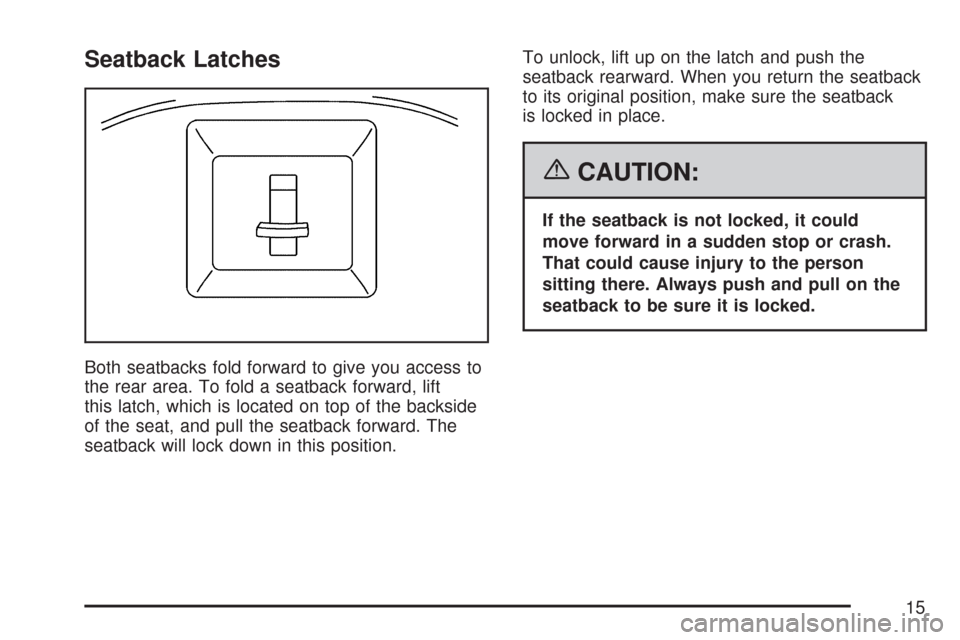
Seatback Latches
Both seatbacks fold forward to give you access to
the rear area. To fold a seatback forward, lift
this latch, which is located on top of the backside
of the seat, and pull the seatback forward. The
seatback will lock down in this position.To unlock, lift up on the latch and push the
seatback rearward. When you return the seatback
to its original position, make sure the seatback
is locked in place.
{CAUTION:
If the seatback is not locked, it could
move forward in a sudden stop or crash.
That could cause injury to the person
sitting there. Always push and pull on the
seatback to be sure it is locked.
15
Page 16 of 488
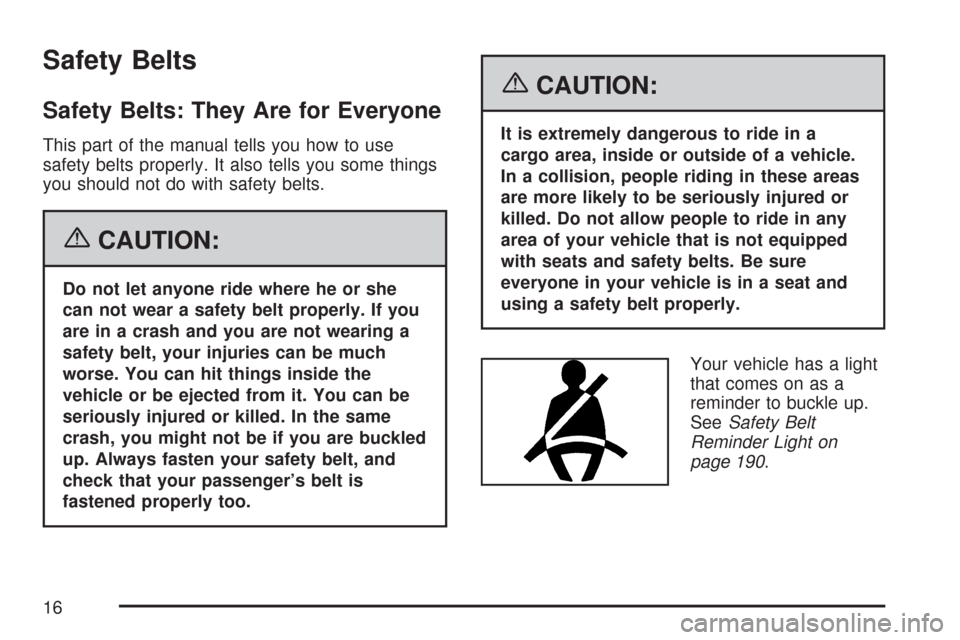
Safety Belts
Safety Belts: They Are for Everyone
This part of the manual tells you how to use
safety belts properly. It also tells you some things
you should not do with safety belts.
{CAUTION:
Do not let anyone ride where he or she
can not wear a safety belt properly. If you
are in a crash and you are not wearing a
safety belt, your injuries can be much
worse. You can hit things inside the
vehicle or be ejected from it. You can be
seriously injured or killed. In the same
crash, you might not be if you are buckled
up. Always fasten your safety belt, and
check that your passenger’s belt is
fastened properly too.
{CAUTION:
It is extremely dangerous to ride in a
cargo area, inside or outside of a vehicle.
In a collision, people riding in these areas
are more likely to be seriously injured or
killed. Do not allow people to ride in any
area of your vehicle that is not equipped
with seats and safety belts. Be sure
everyone in your vehicle is in a seat and
using a safety belt properly.
Your vehicle has a light
that comes on as a
reminder to buckle up.
SeeSafety Belt
Reminder Light on
page 190.
16
Page 17 of 488
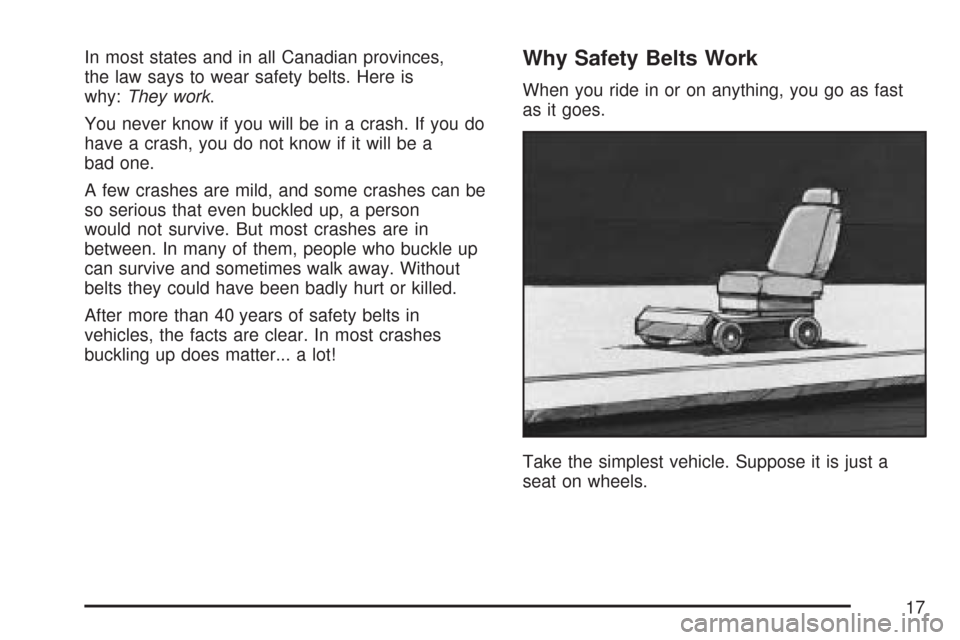
In most states and in all Canadian provinces,
the law says to wear safety belts. Here is
why:They work.
You never know if you will be in a crash. If you do
have a crash, you do not know if it will be a
bad one.
A few crashes are mild, and some crashes can be
so serious that even buckled up, a person
would not survive. But most crashes are in
between. In many of them, people who buckle up
can survive and sometimes walk away. Without
belts they could have been badly hurt or killed.
After more than 40 years of safety belts in
vehicles, the facts are clear. In most crashes
buckling up does matter... a lot!Why Safety Belts Work
When you ride in or on anything, you go as fast
as it goes.
Take the simplest vehicle. Suppose it is just a
seat on wheels.
17
Page 18 of 488
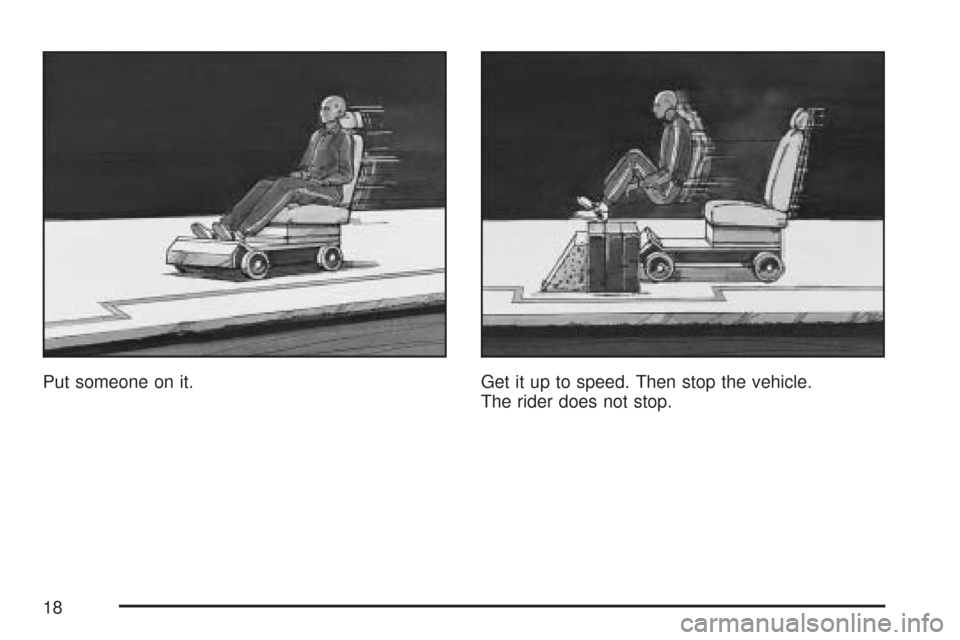
Put someone on it. Get it up to speed. Then stop the vehicle.
The rider does not stop.
18
Page 19 of 488
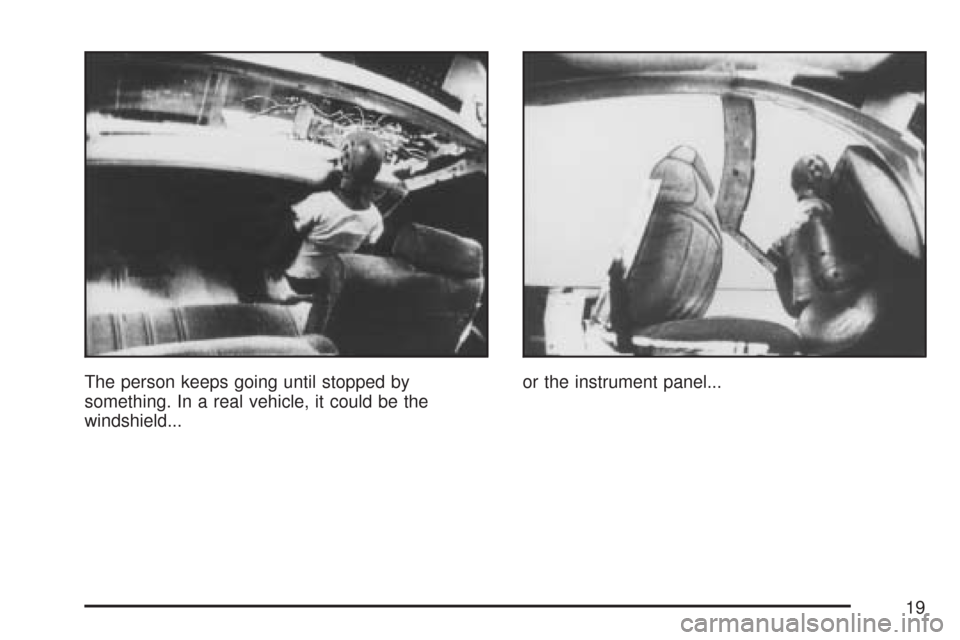
The person keeps going until stopped by
something. In a real vehicle, it could be the
windshield...or the instrument panel...
19
Page 20 of 488
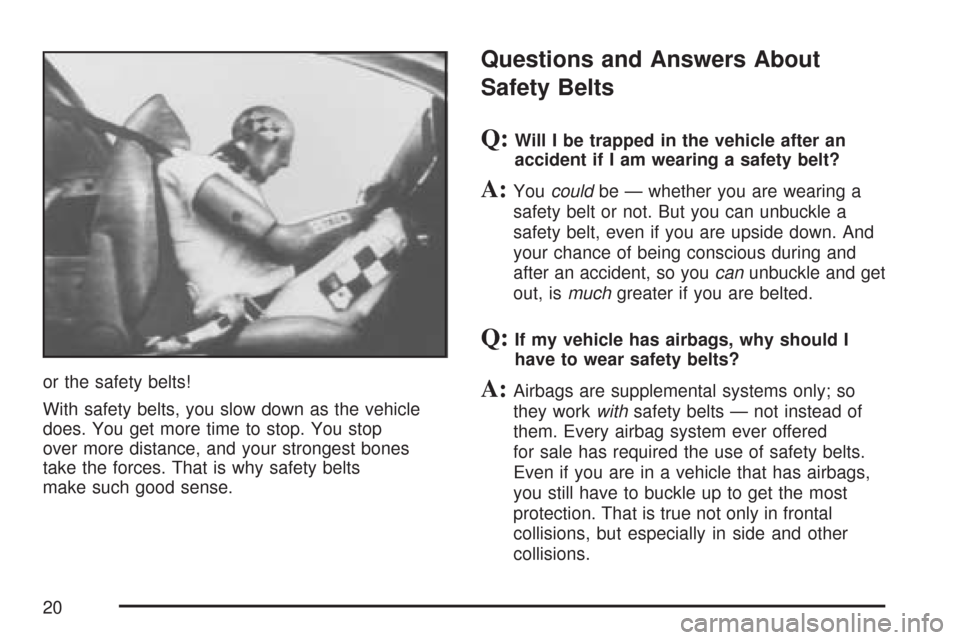
or the safety belts!
With safety belts, you slow down as the vehicle
does. You get more time to stop. You stop
over more distance, and your strongest bones
take the forces. That is why safety belts
make such good sense.
Questions and Answers About
Safety Belts
Q:Will I be trapped in the vehicle after an
accident if I am wearing a safety belt?
A:Youcouldbe — whether you are wearing a
safety belt or not. But you can unbuckle a
safety belt, even if you are upside down. And
your chance of being conscious during and
after an accident, so youcanunbuckle and get
out, ismuchgreater if you are belted.
Q:If my vehicle has airbags, why should I
have to wear safety belts?
A:Airbags are supplemental systems only; so
they workwithsafety belts — not instead of
them. Every airbag system ever offered
for sale has required the use of safety belts.
Even if you are in a vehicle that has airbags,
you still have to buckle up to get the most
protection. That is true not only in frontal
collisions, but especially in side and other
collisions.
20